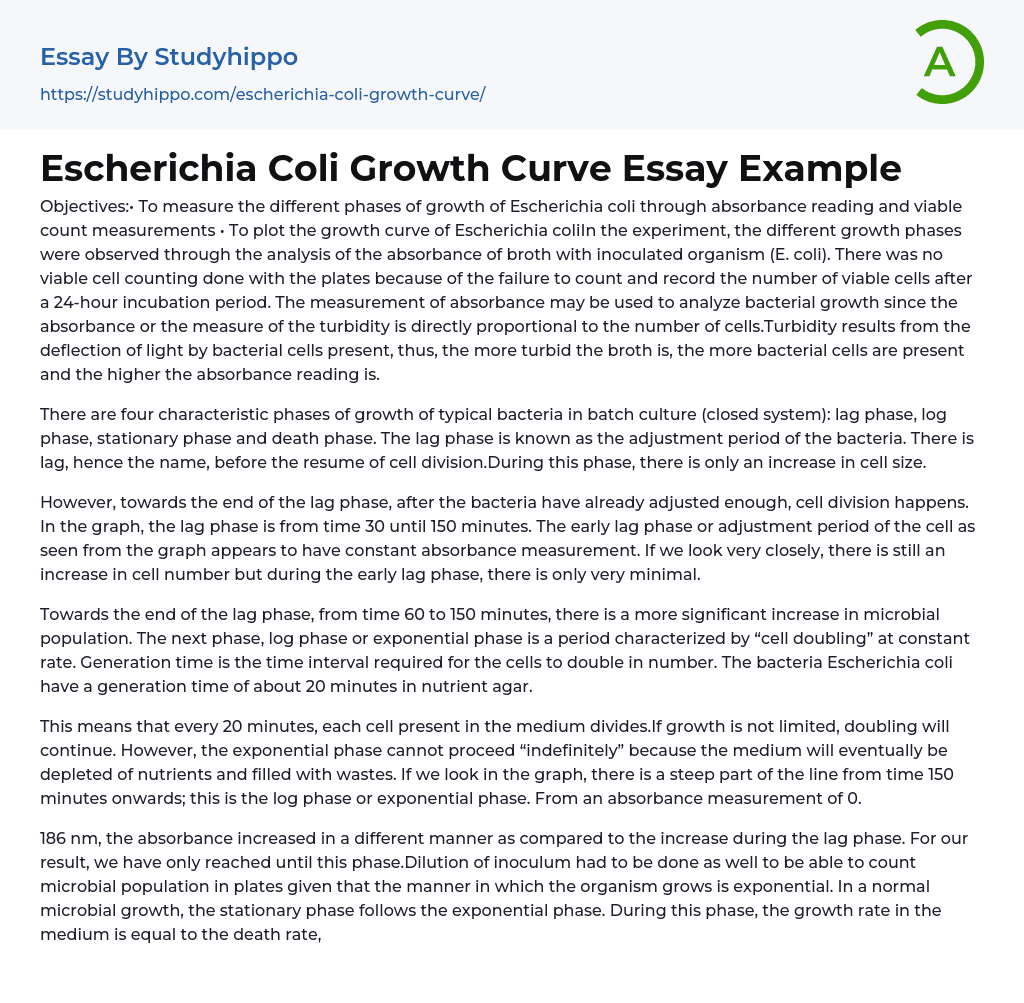Objectives:
- To measure the different phases of growth of Escherichia coli through absorbance reading and viable count measurements
- To plot the growth curve of Escherichia coliIn the experiment, the different growth phases were observed through the analysis of the absorbance of broth with inoculated organism (E. coli).
There was no viable cell counting done with the plates because of the failure to count and record the number of viable cells after a 24-hour incubation period. The measurement of absorbance may be used to analyze bacterial growth since the absorbance or the measure of the turbidity is directly proportional to the number of cells.Turbidity results from the deflection of light by bacterial cells present, thus, the more turbid the broth is, the more bacterial cells are present and the highe
...r the absorbance reading is.
There are four characteristic phases of growth of typical bacteria in batch culture (closed system): lag phase, log phase, stationary phase and death phase. The lag phase is known as the adjustment period of the bacteria. There is lag, hence the name, before the resume of cell division.During this phase, there is only an increase in cell size.
However, towards the end of the lag phase, after the bacteria have already adjusted enough, cell division happens. In the graph, the lag phase is from time 30 until 150 minutes. The early lag phase or adjustment period of the cell as seen from the graph appears to have constant absorbance measurement. If we look very closely, there is still an increase in cell number but during the early lag phase, there is only very minimal.
Towards the end of the lag phase, from time 60 to 150
minutes, there is a more significant increase in microbial population. The next phase, log phase or exponential phase is a period characterized by “cell doubling” at constant rate. Generation time is the time interval required for the cells to double in number. The bacteria Escherichia coli have a generation time of about 20 minutes in nutrient agar.
This means that every 20 minutes, each cell present in the medium divides.If growth is not limited, doubling will continue. However, the exponential phase cannot proceed “indefinitely” because the medium will eventually be depleted of nutrients and filled with wastes. If we look in the graph, there is a steep part of the line from time 150 minutes onwards; this is the log phase or exponential phase. From an absorbance measurement of 0.
186 nm, the absorbance increased in a different manner as compared to the increase during the lag phase. For our result, we have only reached until this phase.Dilution of inoculum had to be done as well to be able to count microbial population in plates given that the manner in which the organism grows is exponential. In a normal microbial growth, the stationary phase follows the exponential phase. During this phase, the growth rate in the medium is equal to the death rate, resulting to a stationary growth.
This results from a growth-limiting factor since during the previous phase, there is cell doubling at constant rate and the medium has limited nutrients only. Lastly at death phase, bacteria run out of nutrients and die.
- Research Methods essays
- Experiment essays
- Hypothesis essays
- Observation essays
- Qualitative Research essays
- Theory essays
- Explorer essays
- Bacteria essays
- Biotechnology essays
- Breeding essays
- Cell essays
- Cell Membrane essays
- Cystic Fibrosis essays
- Enzyme essays
- Human essays
- Microbiology essays
- Natural Selection essays
- Photosynthesis essays
- Plant essays
- Protein essays
- Stem Cell essays
- Viruses essays
- Agriculture essays
- Albert einstein essays
- Animals essays
- Archaeology essays
- Bear essays
- Biology essays
- Birds essays
- Butterfly essays
- Cat essays
- Charles Darwin essays
- Chemistry essays
- Dinosaur essays
- Discovery essays
- Dolphin essays
- Elephant essays
- Eli Whitney essays
- Environmental Science essays
- Evolution essays
- Fish essays
- Genetics essays
- Horse essays
- Human Evolution essays
- Isaac Newton essays
- Journal essays
- Linguistics essays
- Lion essays
- Logic essays
- Mars essays




